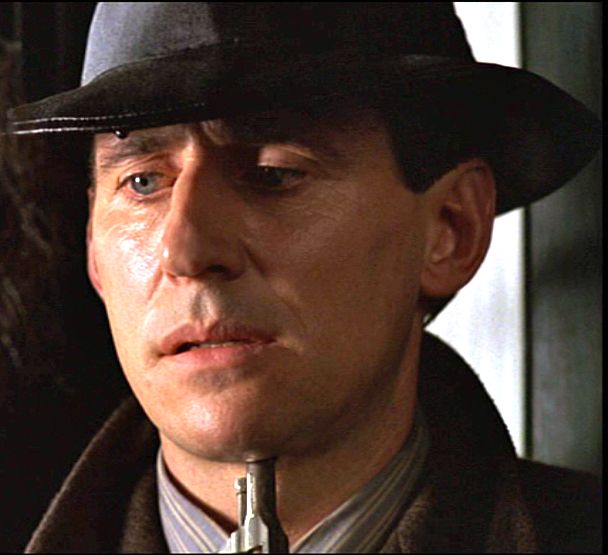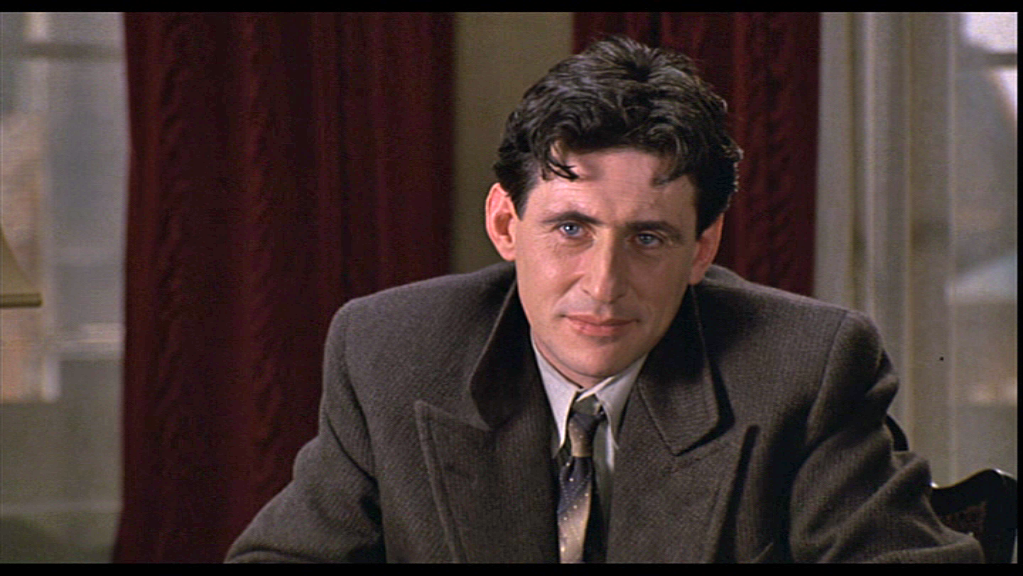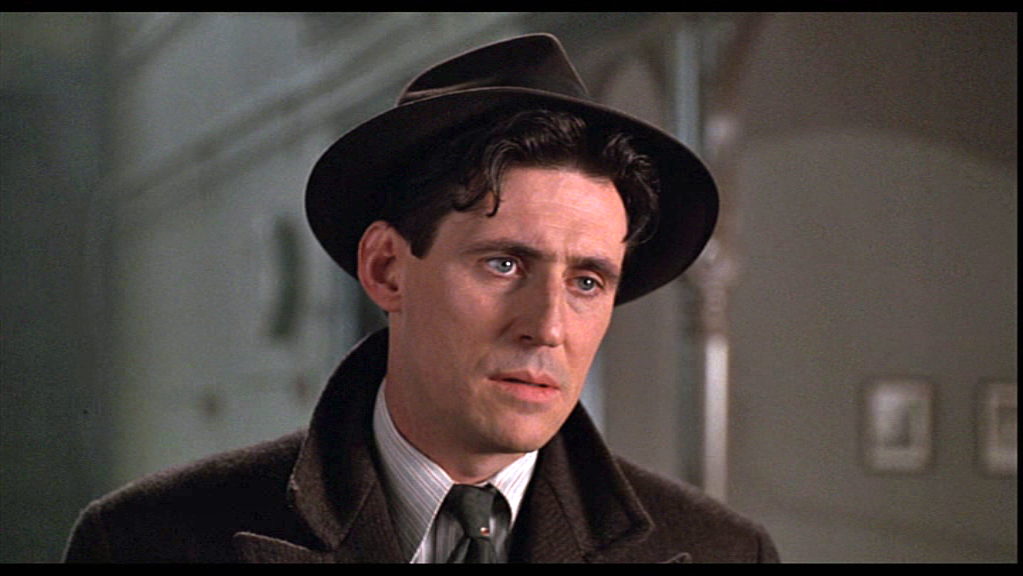Return to Mega Movie Pages Plus
role
Tom Reagan
production
Directed by Joel Coen
Screenplay by Joel Coen and Ethan Coen
Cinematography by Barry Sonnenfeld
Circle Films/Twentieth Century Fox, 1990
Cast includes: Gabriel Byrne, Albert Finney, John Turturro, Marcia Gay Harden, Jon Polito, J. E. Freeman, Steve Buscemi
Rotten Tomatoes: Miller’s Crossing receives a 90% positive rating.
Special notes:
- Excerpt from Gabriel Byrne’s entry in David Thomson’s The New Biographical Dictionary of Film, Expanded and Updated, published in 2004:
Somehow, I always have the urge to reach out and tickle Gabriel Byrne. I think it’s because his uncommon aura of gloom and sadness seems so complete it likely masks a teaser or a practical joker. But looking the way he does, how is he ever going to get cast in a comedy–especially when films incline so naturally towards ruined priests, morose gangsters, and depressed terrorists? And, truth to tell, he did the poker-faced, life-is-short routine so superbly in “Miller’s Crossing” (1990, Joel and Ethan Coen) that he might as well laugh sometimes. That’s not just his best film, it’s one of the best performances in American film–the whole melancholy routine.

- 2. Cinematical: Their Best Role: Gabriel Byrne in Miller’s Crossing
Posting by Alison Nastasi on March 8, 2010 [This article is no longer available on the Internet]
Gabriel Byrne is one of our most talented performers. Yes, he’s appeared in some clunker films over the years (just like everyone else in Hollywood), but choosing his best role was easier than I imagined. People can (and will) make the case for films like The Usual Suspects and I can definitely see where the logic in that choice is. However, for me, it’s all about Miller’s Crossing. Byrne’s portrayal of a “prickly pear” of a man caught in the middle of a gang war embodies everything I love about the actor’s work in general: the smoldering intensity, the subtle nuances of his body language, his gift for making the most mundane dialogue sound cooler thanks to his accent and his ability to make even a deeply flawed character someone the audience can relate to. The role of Tom Reagan may not be a particularly daring choice for Byrne’s best role, but great work is great work and deserves to be celebrated.
taglines
Nothing is what it seems at Miller’s Crossing.
Up is down, black is white, and nothing is what it seems.
synopsis
Joel and Ethan Coen’s third collaboration, the gangster film Miller’s Crossing, stars Gabriel Byrne as Tom Reagan, the right-hand man of big-city Irish mob boss Leo (Albert Finney). The film opens with Italian mobster Johnny Caspar (Jon Polito) and his second in command Eddie Dane (J.E. Freeman) informing Leo and Tom that they are going to kill bookie Bernie Bernbaum (John Turturro) because he has been revealing Caspar’s fixed fights to other gamblers. Leo informs Caspar that Bernie pays for protection and is not to be touched. After the Italians leave in a huff, Tom informs Leo that he should give up Bernie. Tom and Leo are both involved with Verna (Marcia Gay Harden), Bernie’s sister. After a failed hit on Leo starts a full-scale mob war, Tom reveals to Leo the truth about his relationship with Verna. This leads to a falling-out between the pair. Tom goes to work for Caspar, but in truth, he is still loyal to Leo. Tom figures out how to manipulate all of the situations so that Leo survives, but this may cost Tom his relationship with Verna. ~ Perry Seibert, All Movie Guide
trailer
production stills



quotes
Eddie Dane: How’d you get the fat lip?
Tom Reagan: Old war wound. Acts up around morons.—
Tom Reagan: Nobody knows anybody. Not that well.
—
Tom Reagan: Tell Leo he’s not God on the throne, he’s just a cheap political boss with more hair tonic than brains.
—
Tom Reagan: Think about what protecting Bernie gets us. Think about what offending Caspar loses us.
Leo: Oh, come on, Tommy. You know I don’t like to think.
Tom Reagan: Yeah. Well, think about whether you should start.—
Verna: Shouldn’t you be doing your job?
Tom Reagan: Intimidating helpless women is my job.
Verna: Then go find one, and intimidate her.
Verna: That’s not why you came, either.
Tom: Tell me why I came.
Verna: [seductively] The oldest reason there is.
Tom: There are friendlier places to drink.—
Verna: Why don’t we just pick up and leave town? There’s nothing keeping you here. I know there’s nothing keeping me.
Tom: What about Bernie?
Verna: He could go with us.
Tom: You, me and Bernie; where would we go, Verna? Niagara Falls?—
Tom and Verna, discussing hats:
Verna: What´re you chewin´over?
Tom Reagan: Dream I had once. I was walkin’ in the woods, I don’t know why. Wind came up and blew me hat off.
Verna: And you chased it, right? You ran and ran, finally caught up to it and you picked it up. But it wasn’t a hat anymore and it changed into something else, something wonderful.
Tom: No, it stayed a hat and no, I didn’t chase it. Nothing more foolish than a man chasin’ his hat.
Verna: Maybe that’s why I like you, Tom. I’ve never met anyone who made being a son of a bitch such a point of pride.—
Bernie: Look in your heart! Look in your heart!
Tom Reagan: What heart?
screencaps
More screencaps by Aragarna are in the Gallery.
premiere
Life Magazine, September 21, 1990
 Ellen Barkin and Gabriel Byrne
Ellen Barkin and Gabriel Byrne
 Marcia Gay Harden, Joel Coen, John Turturro, Ethan Coen, Gabriel Byrne and Jon Polito
Marcia Gay Harden, Joel Coen, John Turturro, Ethan Coen, Gabriel Byrne and Jon Polito
 Ellen Barkin and Gabriel Byrne
Ellen Barkin and Gabriel Byrne
 Gabriel Byrne and John Turturro
Gabriel Byrne and John Turturro
reviews
Roger Ebert, Chicago Sun Times
(Mr. Ebert did not mention Gabriel Byrne at all in his review and he is not that impressed with the film in general, either…)
“Miller’s Crossing” comes from two traditions that sometimes overlap, the gangster movie of the 1930s and the film noir of the 1940s. It finds its characters in the first and its visual style in the second, but the visuals lack a certain stylish tackiness that film noir sometimes had. They’re in good taste. The plot is as simple as an old gangster movie, but it takes us a long time to figure that out, because the first half hour of the film involves the characters in complicated dialogue where they talk about a lot of people we haven’t met, and refer to a lot of possibilities we don’t understand. It’s the kind of movie you have to figure out in hindsight.
Richard Corliss,Time Magazine [This review is no longer available at Time Magazine. Mr. Corliss died in 2015. RIP to a wonderful movie critic and writer.]
Like Red Harvest [Dashiell Hammett’s novel, upon which Miller’s Crossing is said to be based], but unlike most movies, Miller’s Crossing has a good novel’s narrative density. The film finds a dozen angles in the battle between Leo O’Bannion (Albert Finney), the Irishman who has run the town for years, and Johnny Caspar (Jon Polito), the volatile, flirtatious Italian who is itching to seize control. Their bone of contention is Bernie Bernbaum (John Turturro), a gambler too greedy to live long but too cunning to stay dead. His sister Verna (Marcia Gay Harden) has stolen Leo’s heart and is ever ready to fence it. Nice crowd. Shuttling among them, wooed and wounded by them all, is Tom Reagan (Gabriel Byrne), an existential hero with a black Irish soul. We spend most of the movie racing after Tom’s mind, trying to figure what devious plan it will spin next.

Rita Kempley, The Washington Post
In the leading role of Tom, Byrne is torn — make that shredded — between his fedora-covered head and his scabbed-over heart. The hat, symbolic of Tom’s quandary, leads a life of its own, blowing off in the wind, then magically reappearing on the stair. Like many a Hammett hero, Tom would keep everything under his hat, if only he could keep it on his handsome head. And it’s no accident that the movie’s moll, Verna (Marcia Gay Harden), wins it from him in a game of chance. Love’s a gamble and Tom, in debt to the local loan shark, has a record as a loser…”Miller’s Crossing” is as disturbing and densely beautiful as its opening image, a lofty forest that dwarfs the gangsters as they laugh over their kill. There is an uncompromising magic about this primeval setting, until it comes over you like a wolf’s shadow that this is where the brutal truly belong.
Vincent Canby, The New York Times
”Miller’s Crossing” is a movie of random effects and little accumulative impact. Though both Mr. Byrne and Mr. Finney (who looks very fit these days) give legitimate performances, they are not charismatic screen figures here, nor do they even have the schlocky charm of B-picture actors. They are ciphers. So too is Miss Harden, who gives the impression of being tastefully dolled up for a 1920’s masquerade party.
Overview at The New York Times [This article is no longer available on the Internet]
Comments from a reader: This movie is my favorite of all Coen Brothers movies. I’ve watched it at least five times and it gets better each time. The atmosphere, the characters, the dialogue are unique and compelling. In fact, it is one of the most quotable movies around. The film also delves into the tangled questions of who is good, who is bad, what are ethics and who has has them. And I love the crosses, double-crosses, angles and contradictions that appear throughout the film. I hope the NYT critics will revisit this one and give it another review.
Up there with the Coen brothers’ finest work. Miller’s Crossing is a lush recreation of the period gangster film, invigorated by some fine performances, a devilish plot and sprinkled with some macabre touches that could only come from the minds of Joel and Ethan Coen.
Empire Magazine [the link to this review is no longer available]
The casting is inch perfect. Finney makes the charismatic Leo his own, despite having stepped in at the last possible moment when original choice Sterling Hayden died [Actually, the Coen’s first choice for the role of Leo was Trey Wilson, who died two days before filming was to begin]. Harden, atypically attractive with voluminously mad Dorothy Parker hair, is all twitchy sexuality and pout. While the regular Coen troupe weave their rabbit-mouthed magic (Turturro, Buscemi, Polito — look out, too, for cameos from Sam Raimi and Frances McDormand) as a bunch of slickly attired, self-serving double-crossers. Tom is the converse, his motives are loyalty and friendship — even trust on some deeply buried level, only his method is betrayal. A sack of bitter wisecracks, fuelled by sour bourbon and ever-present smokes, he plays all ends against the middle with rubs of Bogart in his sharp tongue and street loner persona. It’s Byrne’s finest moment, although he struggled with it — those damned elusive brothers. Tom paradoxically gives the movie heart. Fluttering evasively around the edges of Miller’s Crossing is a twisted form of devotion, even love.
posters

 Minimalist poster for Miller’s Crossing
Minimalist poster for Miller’s Crossing
blu-ray box
screencaps from the blu-ray release
discussion
Film Lovers Are Sick People enthusiastically bring you “the greatest Coen Brothers film ever made.”
articles
30 Years of Coens: Miller’s Crossing: The Atlantic/Christopher Orr: An overdue love letter to the extraordinary meta gangster movie
Miller’s Crossing is an intoxicating achievement in cinematic chemistry.
In Gabriel Byrne’s Tom Reagan, the Coens offered their most conventional leading man (smart, handsome) to date, and arguably since. He is by no means a prototypical hero, but he stands notably apart from the parade of schnooks and oddballs who typically populate their films. However flawed, brooding, and even cruel he may be, overall Tom is a sympathetic, attractive, and even admirable character. (Not as admirable as, say, Fargo’s Marge Gunderson, but considerably less offbeat.) These may be “conventional” attributes to look for in a protagonist, but they play a substantial role in why most of us go to the movies. And it certainly doesn’t hurt that Byrne delivers the best performance of his career here. (Yes, better—much better—than that in The Usual Suspects.) Nor were Byrne’s contributions limited to his performance. The Coens initially conceived of their Irish mob characters as fully assimilated: It was Byrne who persuaded them to let him play the character in his natural accent. This was no small feat: The Coens were famous for arriving on set with a finished script and storyboards from which they allowed no deviations. (This was the primary reason for the friction with Nicolas Cage in Raising Arizona: He offered many ideas for tinkering with his character; few, if any, were used.) And if all that were not enough, it was Byrne, too, who recommended “Limerick’s Lamentation,” the traditional Irish song from which Burwell built his magnificent score.
Helen Dudar, The New York Times: “Gabriel Byrne Bound for Miller’s Crossing”
A while back, Mr. Byrne emerged from a viewing of the Coen brothers’ ”Raising Arizona” thinking, now, that’s movie making, and he said to himself, ”I’d like to work with those guys.” He never learned whether the Coens had been similarly inspired by any of his performances; he was a casting director’s recommendation and the first of a number of actors who read for the part. The brothers, he later learned, were initially dubious because they saw the character of Tom Regan as wholly American. Mr. Byrne, who was dazzled by the music of the dialogue, found the language echt Irish. It was, he recalls, like slipping into an overcoat that was a perfect fit.

All-TIME 100 Movies at Time Magazine
In 2005, Time magazine chose Miller’s Crossing as one of the 100 greatest films made since the inception of the periodical. Time critic Richard Corliss said of it:
But in Miller’s Crossing (a reworking of the social chicanery in Dashiell Hammett’s novel Red Harvest), the antagonists are smart and out-smarter. Albert Finney runs a corrupt town in the 1920s, Gabriel Byrne is a brainy sort sometimes allied with Finney, and a stellar lineup of eccentrics (John Turturro, Steve Buscemi, Jon Polito) fills in the background of this marvelous, and pretty serious, fresco. It’s noir with a touch so light, the film seems to float on the breeze like the Frisbee of a fedora sailing through the forest.
Movieline April 1994/Virginia Campbell
Video: Greatish Performances
Gabriel Byrne is an Irish import who’s been in some surreally bad movies over the years, none of them hits. So he cambe baggage-free to the Coen brothers, whose film Miller’s Crossing offered the perfect vehicle for Byrne’s untapped strengths, among which is a face with about as much angularity and dissymmetry as one can hold and still be compellingly handsome. Byrne looks like a brooder with a bad Irish temper and too much brainpower to give it anyting but a short leash. Which is right on the money for Tom Reeagan, the dour, quiet thinker who call shte play for expansive, sentimental crime boss Leo (Albert Finney). But Byrne’s wonderful turn as the Hammett-style, close-to-the-vest operator rests mostly on what he does with his perfectly cast face: less than most actors would ever dare.
“I’m talking about friendship. I’m talking about character. I’m talking about ethics.” Those first words spoken int he deeply ironic Miller’s Crossing come out fo the big mouth of Leo’s psycho-sleaze rival Johnny Casper (Jon Polito). About the time we realize that the issues given such hilarious lip service by Casper are genuine concerns of the reticent gangster Tom, we have also noted that Tom is a bad drinker and a worse gambler and is sleeping with Leo’s “twist,” Verna. How all these contradictory qualms and compulsions cohere within Tom on a good day, much less in the crisis that comes about, is the ultimate mystery that Byrne’s commitment to minimal acting fuels with suspense.
In the many entertaining conversations that propel the tautly convoluted plot of Miller’s Crossing, Byrne plays out Tom’s internal crossfire with small, sero-degree facial reactions that signal complex assessments. Byrne can put an entire diatribe into one 30-degree shift of his eyes. And Tom’s black irony (“you got a lip on ya,” says Casper) is served up tight and deep by Byrne’s precise, reserved delivery of the Coen brothers’ killer dialogue (“What’s the matter with you,” he says to Verna. “Afraid people might get the right idea?”).

But the richest layer of Byrne’s performance is the way he shows us his character’s awareness that what’s ultimately at stake in the power-politics showdown between Leo and Casper is Tom’s own limited, but precious, sense of decency. It’s on this level that Miller’s Crossing can be read as much more the Coen brothers’ movie about Hollywood (a gangland if there ever was one) than Barton Fink–a piffle written when the Coens were suffering writer’s block on Crossing–ever could be. Byrne’s expressive, carefully employed glower portends, as Tom naviates the roiling waters of betrayal, that while Tom may cleverly survive the plot twists with his body intact, his sould will not be so fortunate.
All actors want desperately to be watched. But few possess the skill and confidence it takes to scale a performance back to a visible restraint that forces the audience to watch. Like Al Pacino as the inscrutable Michael Corleone in The Godfather, Part II, Gabriel Byrne makes his audience search out his character. Tom’s mystique in Miller’s Crossing is, next to his brains, his greatest asset, and it is Byrne’s accomplishment that he makes Tom’s mystique appear greater at the end of the film that at the beginning.
My Favourite Film: Miller’s Crossing/Jason Deans for The Guardian
My all-time top celebrity spot? Gabriel Byrne, no question. On a Saturday in July 2003, the morning after two of my best friends marry, I’m in the bar of the Charlotte Street Hotel saying a final farewell before they fly off on honeymoon (also, the newly minted husband needs to borrow cash for the cab to Heathrow). As we swap war stories from the night before, I become aware of a familiar yet unplaceable Irish voice drifting over the conversation from behind me. After a few seconds, it comes to me – “What’s the rumpus?” – so I sneak a crafty glance over my shoulder and there he is: Gabriel Byrne is sitting alone at a corner table, talking on his mobile phone.
I had a crashing hangover – was almost certainly still drunk – and this seemed fitting for the encounter. By this time Byrne was better known for The Usual Suspects, but for me he’ll always be Tom Reagan, the magnificently rumpled, battered but undefeated antihero of the Coen brothers’ 1990 gangster film Miller’s Crossing. The movie is soaked in booze, from the opening closeup of Tom’s whisky glass and the clink-clink sound of ice cubes tumbling in.
In an era when action heroes such as Arnie and Bruce strolled through movies casually offing baddies by the dozen but rarely seeming in any genuine danger, Tom was my kind of protagonist – bumbling from one hazardous encounter to the next, the antithesis of omnipotent. (Likewise, I was drawn to Blade Runner‘s Rick Deckard and Angel Heart‘s Harry Angel.) Perpetually hungover and seemingly clad in the previous night’s soiled threads, reeling from one savage beating or close brush with death to the next, he is all the time ready with a wisecrack (“How’d you get the fat lip?” … “Old war wound. Acts up around morons”), working out the angles, spotting the grifts, prepared to gamble with his life on the next big play.

Ain’t It Cool News: Miller’s Crossing Review by headgeek
MILLER’S CROSSING has a complete and large soul. The film is… at its heart about Friendship and the respect friends give when that relationship has come to an end.
The film is about Tom and Leo. Everything else in the film emanates from this friendship. How do I know? Watch the beginning of the film… Leo tries to help Tom out of his debt, but Tom does not want to be beholden to Leo… not out of fear… but because their friendship isn’t based on what the other can do for each other, but out of a mutual respect. Listen to the dialogue about trading BODY BLOWS… Leo says he can trade body blows with anyone in the city except Tom…. and that is because when coming to blows with Tom, he would lose even if he won. This is the price of friendship.
When Tom admits to the affair he’s been having with Verna… he knows that at that moment he has ended the greatest friendship he has ever known. Even if they were to reconcile, he realizes that he has crossed the street in a friendship that you never cross. He’s lost his friend’s trust forever. He could pick up and leave, but he still loves his friend… sees him in danger. He must help his friend one last time… And then he will have to leave. He does this not out of debt… not because Leo will reward him… not because it will personally help him… But because his friend needed help… and even if their friendship was over… the feelings he has for Leo are not. He must leave with everything on an even plane… Like with free masons, they must part on the square.
There is more honest soul in this relationship and the entire purpose of this film than I dare say any film any of you can think of. The goodbye gift of a life long friendship come to an end. And if you can’t see that, then the soul you see missing is your own.

production notes
Everyone who worked on the film was also full of praise for the meticulous preparation which guaranteed a tranquil set and enabled the filmmakers to do a complex period film on a relatively small budget. At the same time, actors and technicians alike were pleased to learn that within the limits set by a script that rarely changed and a carefully workedout visual plan, the Coens’ method, like Tom’s, is one of controlled improvisation, continually open to creative surprises.
A notable example of this was Gabriel Byrne’s Irish accent. Tom wasn’t written as first-generation Irish, but Byrne says, “When I read the script out loud to myself, I said ‘My God, this could have been written by somebody from Dublin!”‘ When he met the Coens, he proposed playing the character with an accent.
“We were skeptical,” recalls Joel, “but we said, ‘Fine, go ahead, try it.’ He did it and we liked the way it sounded.” And when Albert Finney was cast two days before the start of shooting due to the sad loss of Trey Wilson, who was to have played Leo, Tom’s mentor also acquired an Irish accent.

Hats were given a lot of thought, and so were the other accessories. Hornung observes: “The characters in this movie don’t open up, don’t reveal themselves at any point, so the Coens wanted brims very broad and down over people’s eyes, often shadowing them. People are very covered up in this. They have gloves, they’re covered from head to toe, and often they have big coats, which is not really the period.”
The selection of Gabriel Byrne’s hat in particular was a long process. “The hat really becomes a big symbol in the film,” notes unit manager Ron Neter. “Every time Tom gets knocked down, the hat falls off, and people are always handing it back to him.” Five identical hats were made for Byrne to wear during the filming, but another “generic” one was used for the opening shot of the credits: a hat blowing away from the camera across a field, which was filmed at high speed using a special lightweight hat that could be controlled with a fishing line. This shot, the last to be filmed, “was one of the first images we wrote,” according to Ethan. “The idea of the hat blowing away in the woods, without really knowing how it was supposed to fit in.” Unlike the other early image of thugs in the woods, this one was left unexplained and floating free of any plot connection, except for a dream Tom describes at one point to Verna.
Read more Miller’s Crossing Production Notes

gabriel byrne DVD interview
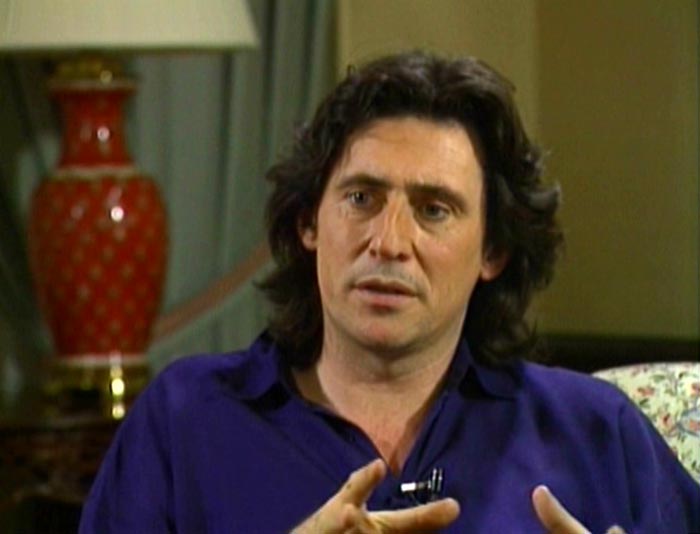


More screencaps from the interview are in the Gallery.
fan art
 Gabriel Byrne Picspam: Miller’s Crossing by Bowie28
Gabriel Byrne Picspam: Miller’s Crossing by Bowie28
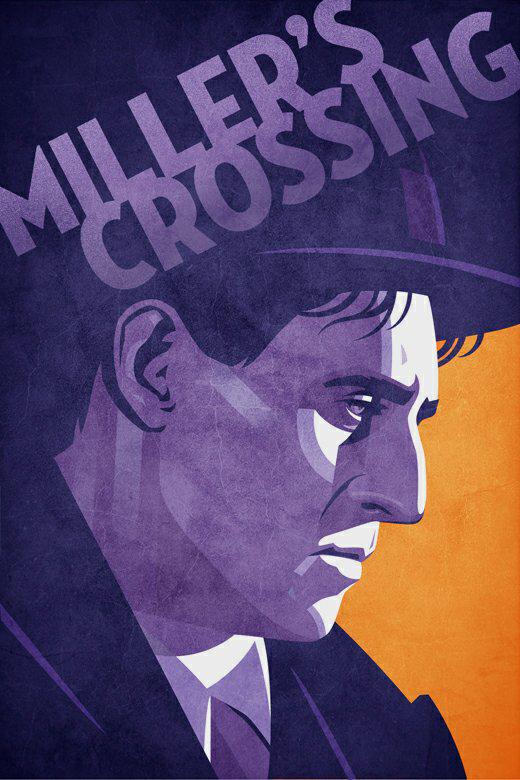 Miller’s-Crossing by mgelen on DeviantArt
Miller’s-Crossing by mgelen on DeviantArt
 Miller’s Crossing Quotes, by Chet Phillips
Miller’s Crossing Quotes, by Chet Phillips
fan video
script
There are various versions of the complete script for Miller’s Crossing available online at multiple websites. This link takes you to a page that lists them all.
Sample: Page 1

soundtrack
Carter Burwell, score
Complete Soundtrack
Review of the soundtrack CD by Victor at Amazon:
WHY THE MILLER’S CROSSING SOUNDTRACK IS ESSENTIAL… May 27, 2002
By VICTORFormat:Audio CD
This album doesn’t “rock”, nor is it “like, really cool.” It is however, one of the moodiest, most evocative film scores of the nineties. Carter Burwell again partners with the acclaimed writing/directing/producing Coen brothers to present a perfect accompaniment to their stylish, dark and brooding portrayal of 1920’s gangsterism in “some dirty eastern city.” The film does incorporate one of the most overused, but here, beautifully mounted versions of the Irish standard “Danny Boy” into the soundtrack, but the film’s wonderfully melancholy opening theme may possibly now have been used in more modern movie trailers than any other music. Yes, we all know that it’s also been used in a beer ad, but Gabriel Byrne himself told me at the 2001 Florida Film Fest in Orlando that it’s actually a beloved and traditional Irish standard titled “Limerick’s Lament” and that he actually had a lot of influence on the Coen’s and Burwell’s eventual changing of the soundtrack to an Irish flavor. If you’re like me and are a huge fan of this, one of THE BEST Coen brothers films, not owning the soundtrack to it is like enjoying a sumptuous meal prepared by wonderfully expert and gifted hands, and skipping the dessert…the experience is simply incomplete.
Martin Hayes and Dennis Cahill performing The Lament for Limerick:
additional resources
TV Tropes for Miller’s Crossing
Includes an exhaustive analysis of the various tropes used through-out the film (a great read!), trivia, awesome scenes, the drinking game, and more!
Some might think the Coen brothers incorporated just about every term ever used in the 1920’s into their script for Miller’s Crossing.
Examples:
Dangle: To leave. Mayor: “We can dangle, Leo, if you’d prefer.”
What’s the rumpus?: To say ‘What’s up?’, ‘How are you?’ Mink: “‘Lo Tom. What’s the rumpus?”

Verna: What happened last night?
Tom looks at her evenly.
Tom: I went to a bar. Passed out. When I got back to my place they were both dead.
Verna studies him.
Verna: …Passed out, huh?
Tom: YeahShe looks at him a beat longer, then out at the floor.
Verna: It’s funny, I’ve never even seen you sleep – though you told me once about a dream you had.
Tom: Maybe I lied.WHAP! Verna slaps him hard. His head rocks under the blow.
Verna: You’ve never been straight with me about anything! You are a sonofabitch!
Tom watches her go.
He raises the drink and rolls it across his slapped cheek.
The ice cubes clink.
The Coens originally wanted actor Gabriel Byrne to give an American accent. But Gabriel read with his natural Irish accent and they loved it.
IMDB page for Miller’s Crossing
Wikipedia page for Miller’s Crossing
Thanks to Aragarna for the screencaps, to Daniela for the script, and to the Fan Artists!
